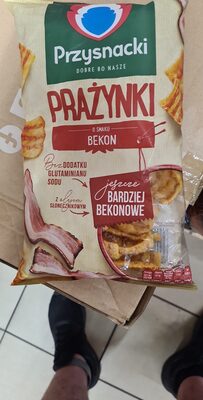Przysnacki - 65 g
This product page is not complete. You can help to complete it by editing it and adding more data from the photos we have, or by taking more photos using the app for Android or iPhone/iPad. Thank you!
×
Barcode: 5900073020224 (EAN / EAN-13)
Quantity: 65 g
Brands: Przysnacki
Categories: Snacks, Salty snacks, Appetizers, Chips and fries, Crisps
Labels, certifications, awards: No added MSG, No flavour enhancer, No MSG, With Sunflower oil
Countries where sold: Poland
Matching with your preferences
Health
Ingredients
Food processing
Additives
Ingredients analysis
The analysis is based solely on the ingredients listed and does not take into account processing methods.
Nutrition
Serving size:
30 g







